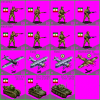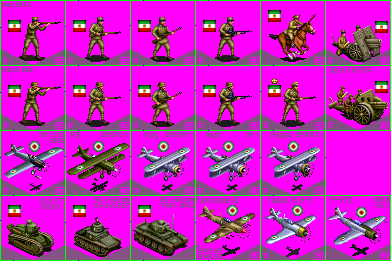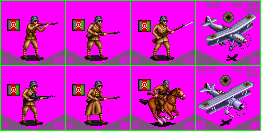You are using an out of date browser. It may not display this or other websites correctly.
You should upgrade or use an alternative browser.
You should upgrade or use an alternative browser.
WW2 Unit Graphics
- Thread starter Arthedain
- Start date
Tanelorn
Deity
In the summer or off combat duty? It is a game thing, I use field caps to differentiate between divisions (in helmets) and brigades/ regiments or static garissons. I doubt anyone with half a lick of sense would go into combat without head protection if he had a choice.
And wasn't in the tropics or a desert, like north Africa.
@gapetit , @JPetroski thanks!
And wasn't in the tropics or a desert, like north Africa.
@gapetit , @JPetroski thanks!
Tanelorn
Deity
Turkey in WW2 or how both the axis and allies got suckered into arming them for free while making promises to both. After doing a 180 on Stalin, they had a defence treaty with the Anlgo-French but it is 1940 so forget about it. Can you spot when they promised lil- Adolph they would attack uncle Joe, to whom they were allied since the 20s? Or when the allies armed them to the teeth and they did nothing until 23 February 1945. With the allies on the Rhine and the Soviets having crossed the Oder, they declared war on the Germans! Shocking, I know...
And then of course they had to run and join NATO, uncle Joe was coming.
Attachments
Patine
Deity
- Joined
- Feb 14, 2011
- Messages
- 12,142

Turkey in WW2 or how both the axis and allies got suckered into arming them for free while making promises to both. After doing a 180 on Stalin, they had a defence treaty with the Anlgo-French but it is 1940 so forget about it. Can you spot when they promised lil- Adolph they would attack uncle Joe, to whom they were allied since the 20s? Or when the allies armed them to the teeth and they did nothing until 23 February 1945. With the allies on the Rhine and the Soviets having crossed the Oder, they declared war on the Germans! Shocking, I know...
And then of course they had to run and join NATO, uncle Joe was coming.
Weren't they tentatively willing to provide the airstrip for Operation Leapfrog - what would have been the biggest "decapitation strike" in modern military had it happened, but then got cold feet after a Turkish national-double-agent-spy spilled the beans to someone?
Tanelorn
Deity
Pahlavi Imperial Iranian army and airforce of WW2. Operation Countenance - the joined Anglo-Soviet invasion and ocupation of Iran was largely unopposed.
They wore and carried a weird mix of equipment. Tzarist style gymnastiorkas, French style kepis, Czech made mausers and German stahlhelms.
Iranian Hawker Furys and Hinds had mercury radial engines.
Also, Russian style cavalry:
Iranian Curtiss Hawk 75 a-9. 10 of these were captured by the British in their boxes and sent to RAF India to serve as Mohawk IV. There is a picture of one of these in test flight, in the US, bearing partial Iranian markings.
Reza Shah's Imperial guard, in full Tzarist kit. Because of the black and white photos I only assume the stripes are red because in later Persian guard uniforms they are so. They could be light blue.
Iran never had P40s, despite what you might read on the internet.
@Patine Link please.
Attachments
Last edited:
Tanelorn
Deity
More WW2 (and thereabouts) Persians:

I keep reading that Reza Shah's unit, the Iranian Cossacks - prior to his ascension to power, owed its allegiance to the Russian empire and then the Whites. I don't know how this worked, other than its officers being Russian. That explains the Russian looks, to some extent. Also, it seems that the Shah was already pro-allied but the Anglo-Soviet invasion went ahead to preempt a pro-Axis coup such as the one in neighbouring Iraq. But mostly to secure the supply line to the USSR and cut off the invasion route to the Caucasus oilfields through Turkey.
I keep reading that Reza Shah's unit, the Iranian Cossacks - prior to his ascension to power, owed its allegiance to the Russian empire and then the Whites. I don't know how this worked, other than its officers being Russian. That explains the Russian looks, to some extent. Also, it seems that the Shah was already pro-allied but the Anglo-Soviet invasion went ahead to preempt a pro-Axis coup such as the one in neighbouring Iraq. But mostly to secure the supply line to the USSR and cut off the invasion route to the Caucasus oilfields through Turkey.
Attachments
Last edited:
Tanelorn
Deity
WW2 era royal Afghan army, under Nader Shah. Their uniforms show WW1 British and German influence, epecially the officers. No beards whatsoever. They carry ex British P14 Elfields, which they would replace with SMLEs & mosins (and standard WW2 battledress btw) after the war. Their helmets are German M14s they adopted in 1930 and they wpuld keep them until the 1979 communist takeover. Now they are sold as Alexander's helmets to tourists, with random bits soldered on. I read somewhere they were actually of Austrian make, I have no clue. The sole extant Ro.37 sits at the grounds of the Italian embasy in Kabul. The only picture I found of one was a silver one during construction, at the factory, in Italy. The Hawker Hinds and 8 older Harts were used extensively during the 1944-1949 Safi revolt.
In the old pictures, the Afghan army looks sharp and the country looks suprisingly civilized.
-edit- Eight of the Polish Renault FT 17 tanks the Soviets captured in the 1919-20 war were presented by the USSR to the Afghan king in 1923. These were in service up to the 50s. One was flown back to Poland in 2012.
Attachments
Last edited:
Patine
Deity
- Joined
- Feb 14, 2011
- Messages
- 12,142

WW2 era royal Afghan army, under Nader Sah. Their uniforms show WW1 British and German influence, epecially the officers. No beards whatsoever. They carry ex British P14 Elfields, which they will replace with SMLEs & mosins (and standard WW2 battledress btw) after the war. Their helmets are German M14s they adopted in 1930 and they wpuld keep them until the 1979 communist takeover. Now they are sold as Alexander's helmets to tourists, with random bits soldered on. I read somewhere they were actually of Austrian make, I have no clue. The sole extant Ro.37 sits at the grounds of the Italian embasy in Kabul. The only picture I found of one was a silver one during construction, at the factory, in Italy. The Hawker Hinds and 8 older Harts were used extensively during the 1944-1949 Safi revolt.
In the old pictures, the Afghan army looks sharp and the country looks suprisingly civilized.
Since you're doing isolated Asian neutrals, are we going to see the Tibetan Army (which was probably virtually unchanged by the time Mao marched in 14 years after the war ended)?
Tanelorn
Deity
Patine
Deity
- Joined
- Feb 14, 2011
- Messages
- 12,142
Tanelorn
Deity
Boring
Patine
Deity
- Joined
- Feb 14, 2011
- Messages
- 12,142
Boring
Than it should be easy?
CurtSibling
ENEMY ACE™
- Joined
- Aug 31, 2001
- Messages
- 29,462
Why not have a go yourself, Patine...? Seriously...Try some pixel tweaks.
- Joined
- Jan 24, 2011
- Messages
- 5,004
Why not have a go yourself, Patine...? Seriously...Try some pixel tweaks.
I do wish some of you artists would post a video of how you do what you do. For one, I think it would be fascinating, but for two, very helpful to tackle some odds and ends myself.
Patine
Deity
- Joined
- Feb 14, 2011
- Messages
- 12,142
Why not have a go yourself, Patine...? Seriously...Try some pixel tweaks.
Doing the Tibetan flag as a flag shield I think would actually be the hardest part of it, Curt. That's a really busy flag.
CurtSibling
ENEMY ACE™
- Joined
- Aug 31, 2001
- Messages
- 29,462
Just make an abstraction or symbol that suits the nation.
Patine
Deity
- Joined
- Feb 14, 2011
- Messages
- 12,142
How are the Tibetans coming along Patine? While you're at it, we don't have any Bhutanese WW2 soldiers.
I don't know if Bhutan had it's own army at that time (except maybe a Royal Guard). They were still a British Protectorate then.
Tanelorn
Deity
Caproni Ca 114 fighter, Peru - Zarumilla war 1941.
The Caproni Ca.114 was developed in 1933 for the Regia Aeronautica. The engine used was the Bristol Mercury radial engine, probably the reason why although the Ca.114 was lighter than the competing Fiat CR.32 and accordingly had a higher rate of climb, it did not emerge as the winner of the competition. In 1935 , this plane set a world record, reaching an altitude of 14,433 m.
Despite the defeat in the competition, several Ca. 114 (12 seems more likely than 36) were manufactured for export to the Peruvian Air Force, in service from 1934. In 1941 it was used in combat during the war between Peru and Ecuador. The plane served as a fighter until 1942 and as a trainer up to 1944.
Attachments
Similar threads
- Replies
- 12
- Views
- 528
- Replies
- 3
- Views
- 334








